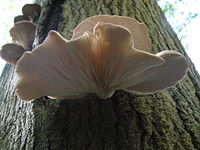
Photo from wikipedia
Despite a large amount of published research on the production of ligninolytic enzymes, the latter are not yet being applied to combat environmental pollution. No cost-effective process has been developed… Click to show full abstract
Despite a large amount of published research on the production of ligninolytic enzymes, the latter are not yet being applied to combat environmental pollution. No cost-effective process has been developed to date. This study describes an improvement of the solid-state fermentation procedure for the production of ligninolytic enzymes via Phanerochaete chrysosporium ATX by applying the Taguchi method and using an agro-industrial waste as substrate. The production of lignin peroxidase (LiP), manganese peroxidase (MnP), and laccase (Lac) were simultaneously increased within a packed-bed column. The factors and levels studied were humidity (A: 60, 70, 80%), inoculum concentration (B: 7.5, 10.0, 12.5 × 105 spores/mL), packed density (C: 0.14, 0.16, 0.18 g/mL), and time (D: 6, 8, 10 days). The results showed that humidity was the factor with a higher effect upon LiP and Lac's production, while time was for MnP. Humidity exerted the greatest influence on the global desirability of the process. Improved conditions (A, 60%; B, 1.0 × 106 spores/mL; C, 0.17 g/mL; D, 8 days) were further validated: the results revealed an overall desirability increase of 237% over the unoptimized process. Process performance was likewise maintained at a higher scale (1:10). The results contribute to establishing a cost-effective bioprocess to produce ligninolytic enzymes by reducing the cost associated with raw materials and purification steps.
Journal Title: Journal of environmental management
Year Published: 2021
Link to full text (if available)
Share on Social Media: Sign Up to like & get
recommendations!